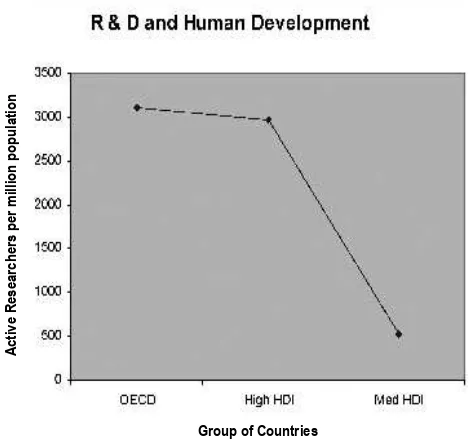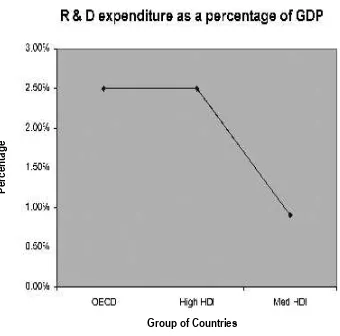1. The changing role of medical schools
The functions of a modern medical school include not only providing the traditional undergraduate and postgraduate training in medicine, and conducting research (involving basic, strategic and applied research or medical technologies), but also supporting the national health services, the wider community, the business sector and government with appropriate expert knowledge. The latter wider functions are particularly important if government or public funding is used in supporting the medical school. In organizing its Annual Academic Sessions, the Institute of Medicine of the Universiti Brunei Darussalam aims to fulill this expected wider societal role.
2. Trends in expenditure on health and medical
research
The health sector consumes a major part of the budget in most countries, being approximately 9% of the Gross Domestic Product (GDP) in most Organisation for Economic Cooperation and Development (OECD) countries [Figure 1, Ref 1]. In 2003, the USA spent 15.3% of GDP on health which is slightly more than four times that spent on defence. These igures give an indication of the priority ascribed to health in many human societies. In Brunei, approximately 6-8% of the national budget is presently devoted to Health, according to available government statistics. Data available for the years 1999 to 200 for the OECD countries are presented in Figure 1. Importantly, the OECD data show that the proportion of GDP spent on health is increasing in most countries, including those with
Promoting health sciences research in Brunei Darussalam
R. Ramasamy
Institute of Medicine, Universiti Brunei Darussalam
rapidly growing economies like Korea and Mexico [1]. In the USA, which may be regarded as being in the forefront of developing new knowledge pertaining to health, medical research is estimated to constitute approximately 5-10% of the total expenditure on health.
Figure1. Graph illustrating the trend in the average national health expenditure as a percentage of the gross domestic product in countries of the Organisation for Economic Cooperation and Development (OECD) for the period 1999 to 200 [Data from Ref 1]
3. Promoting research in the health sector
Much of the increase in life expectancy in 1950-2000 is generally accepted as being due to advances in medical knowledge and medical technology, and not merely the better delivery and better use of existing knowledge and technology. It is therefore useful to analyze in detail some of the beneits of promoting health research.
1. Research provides appropriate training for improving skills of health-sector personnel in evidence-based medicine
2. Solutions for local health problems are often found through what is termed applied research
R. Ramasamy / Brunei Darussalam Journal of Health Volume 1, 2006
Correspondence
Institute of Medicine, University Brunei Darussalam, Jalan Tungku Link, Gadong BE1410, Brunei Darussalam Tel: +673- 2463001 ext 1951
Email: ramasamy@im.ubd.edu.bn
Year
P
er
5 Promoting Health Sciences Research
3. Improving the delivery of health care involves what is termed health systems research
. Research that seeks to advance human knowledge for its own sake, termed basic, fundamental or blue sky research, not only satisies the innate curiosity of the brightest minds, but has been shown to yield unexpected applications in improving medical treatment and diagnosis. The discovery of monoclonal antibodies is a well-known example. Here, Kohler and Milstein stumbled upon the method of making monoclonal antibodies while investigating the basic molecular mechanisms involved in generating diversity in antibodies [2]
5. Most medical research however falls into the category of strategic or applied research, i.e. research that is ultimately designed to improve medical technology and knowledge, which in turn translates into better health care
6. Concomitant research activity often translates into better teaching by the faculty in medical schools. It helps to maintain interest in new developments and serves to attract and retain good faculty
7. Ultimate outcome in promoting research into health is of course the creation of a healthier society
4. Key components to building capacity in health
sciences research
The essential components of building the capacity to perform health related research are:
1. Personnel 2. Institutions 3. Infrastructure
. Regulatory framework 5. Investment
4.1 Personnel
There is a clear correlation between the state of economic and social development of different countries and the numbers of active researchers (scientists including medical scientists and engineers). The results from the
annual United Nations Development Programme (UNDP) human development reports show the relationship between numbers of researchers and OECD countries, countries with a high human development index (regional examples are Brunei and Malaysia) and countries with a medium level of human development of which China, India, Russia and Thailand are examples [Figure 2, Ref 3]. OECD data also suggest that higher education and overall technological sophistication have a major impact on the capacity to innovate (measured in terms of patents obtained) in different countries [1].
4.2 Institutions and Infrastructure
Where research and development is carried out, and its composition, has an additional impact on innovative capacity in different countries. In many OECD countries R&D spending by business is more productive than that by government. However government tends to support basic research unlike business. Innovation productivity is higher for countries specialized in (broad) technology areas, e.g. Korea in electronics.
Figure 2. Graph illustrating the trend in the average numbers of researchers in the countries of the Organisation for Economic Cooperation and Development (OECD), countries with a high human development
index (HDI) and medium human development index as deined by the
United Nations Development Program
Group of Countries
A
ctive R
esear
cher
s per
6
Universities play important multiple roles in translating funding into innovation performance, and therefore good universities with adequate inancial and infrastructure support are essential for productive research. Infrastructure is not only the buildings and laboratories or workshops where research is done, but also involves less obvious factors such as reliable water and electricity supplies, transport, maintenance, rapid procurement mechanisms for laboratory supplies, good housing for staff and provision of trained supporting staff such as technicians, secretaries and managers. Therefore national infrastructure investments and policies have a signiicant impact on innovative output.
4.3 Regulatory framework
Regulations protecting intellectual property and promoting openness to international trade also inluence
innovative capacity, particularly for business. The tax
incentives provided by the government to commercial
establishments for performing in-house research is a signiicant driver for innovation in many OECD countries.
4.5 Investment
Like investment in higher education for training scientists
and engineers [Figure 2] correlating with the state of
development in a country, there is a parallel relationship
between national investment in research and development
and the developmental status [Figure 3]. It is generally
accepted that a minimum of 2% of the GDP of nations
needs to be set aside for research and development for
them to remain globally competitive in the 21st century.
R. Ramasamy / Brunei Darussalam Journal of Health Volume 1, 2006
Figure 3. Graph illustrating the trend in the average proportion of the gross domestic product (GDP) devoted to research and development in the countries of the Organisation for Economic Cooperation and Development (OECD), countries with a high human development index (HDI) and medium human
development index as deined by the United Nations Development Program
Group of Countries
P
er
ce
nt
7
5. Requirements in Brunei Darussalam
Despite its high human development index as deined by the UNDP [1], Brunei clearly needs to develop more trained scientists for clinical and biomedical research to reach parity in research output with the OECD countries. Efforts can be made to attract medical graduates into research. However the requisite infrastructure in terms of research laboratories, major equipment, non-academic support staff, literature resources, needs to be developed in parallel to build human capacity for innovation and research.
There is also a need for speciic funding for health sector research that should involve peer-review of proposals and block grants for developing infrastructure in speciic ields. Additionally, collaboration with established centres of excellence in OECD countries is beneicial and desirable.
The regulatory framework should be improved further to facilitate research and innovation, e.g. purchasing speed, support on intellectual property issues, and greater freedom of interaction of staff between UBD and the Ministry of Health, and between UBD and foreign research centres
It is natural that the Institute of Medicine, UBD should play a key role in promoting health sector research in Brunei Darussalam. Well equipped laboratories and ongoing state of the art research at the Institute can attract collaboration from medical staff in hospitals and overseas scientists.
6. Some strategic advantages of Brunei in Health Sector
research
Focusing on areas where countries have some advantages for innovative output in research is a common practice. These may be summarized in the context of the Bruneian health sector as follows:
1. Brunei has a small and easily accessible population. Good medical and personal records are maintained. This would facilitate studies on molecular epidemiology of human disease
2. The relative genetic homogeneity within distinct populations within the country is extremely useful for pharmacogenetic studies
3. The good hospital care and health sector infrastructure in the country easily permits clinical trials of new therapeutic procedures and drugs
. The rain forests of Brunei and the surrounding seas are rich in biodiversity. There is also a local tradition of using plant extracts for medical treatment. Such traditional knowledge can provide useful leads for discovering new programmes pertaining to strategic areas for development. The latter category of funding would need to be more substantial than the former. A joint committee of the Ministry of Health and the Institute of Medicine, UBD may be established to select research grant applications for funding and to develop procedures [e.g. regulatory] for an enabling research environment. Efforts should also be directed towards meeting the other requirements outlined in Section 5.
8. References
1. OECD Health Data. Organisation for Economic Cooperation and Development.
2. Kohler G, Milstein C 1975. Continuous cultures of fused cells secreting antibody of predeined speciicity. Nature 256: 95-97.
3. Human Development Report 2006. United Nations Development Program. Palgrave Macmillan.

